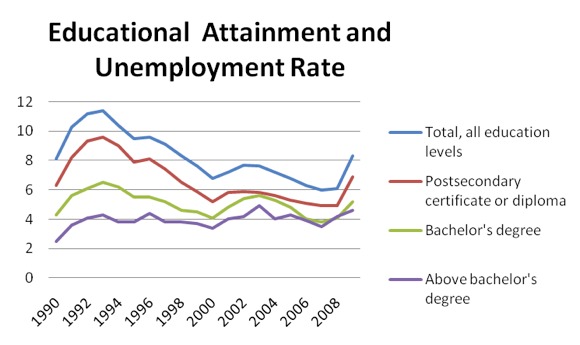
Stats Can’s Data Shows a 20 year Correlation Between Education and Employment

Source: Statistics Canada Labour Force Survey
The unemployment rate has ebbed and flowed over the years. However, Statistics Canada’s labour force survey finds little change in the connection between employment and education over the past 20 years.
The highest unemployment rate is always among those without a high school education: It was 12.2% for persons aged 15 and older in 1990, and 15.9% in 2009. In contrast, the rates among those with a post-secondary education are consistently lower than the national unemployment rate: only 6.3% in 1990 and 6.9% in 2009; but 3.8% and 5.0% respectively for those with a university degree.
The unemployment rate for high school dropouts has fallen significantly deeper than any other group. The difference between the 1990 and 2009 rate was only .2% for all education levels but 3.2% for those with only some high school.
The employment edge remains with those who have more education, even during recessionary periods. In 1993, those with some high school had an unemployment rate of 17.1%, which was 5.7 above the average of 11.4%. Whereas those with a post-secondary certificate saw a rate of 9.6% and a university degree only 5.8%.
While having more than a bachelor’s degree has provided a cushion from unemployment over the years, its importance appeared to diminish slightly. In 1990, those with a bachelor’s degree had an unemployment rate of 4.3%, but that crept up to 5.2% in 2009, while those above a BA started with 2.5%, but that almost doubled to 4.6% in 2009. During this same period, the unemployment rate had only increased .2% although it should be noted these rates are still significantly lower than the Canadian average.
The correlation between employment rates and education level appears more significant in poorer parts of Canada. Data shows the employment rate for high school dropouts aged 25-64 in Newfoundland and Labrador in 2007 was 37.8% while it was only 64.3% and 78.2% for high school and college or university graduates respectively. The employment rate for high school dropouts was consistently lower than the national average, from Quebec all the way out east to PEI. While employment was above the national average from Ontario west to British Columbia, it was still incrementally better for each type of educational attainment.
There’s also a clear relationship between education and earnings. Data from the 2007 Survey of Labour and Income Dynamics reveals the severe economic disadvantage of not having completed high school. Those reporting upper secondary or post-secondary non-tertiary education reported, on average, 75% higher earnings in Canada with certain provinces reporting rates much higher or lower depending on labour markets.
In effect, both current and historical data still support the notion that students should stay in school to assure their future employment and economic success.


Leave a Reply